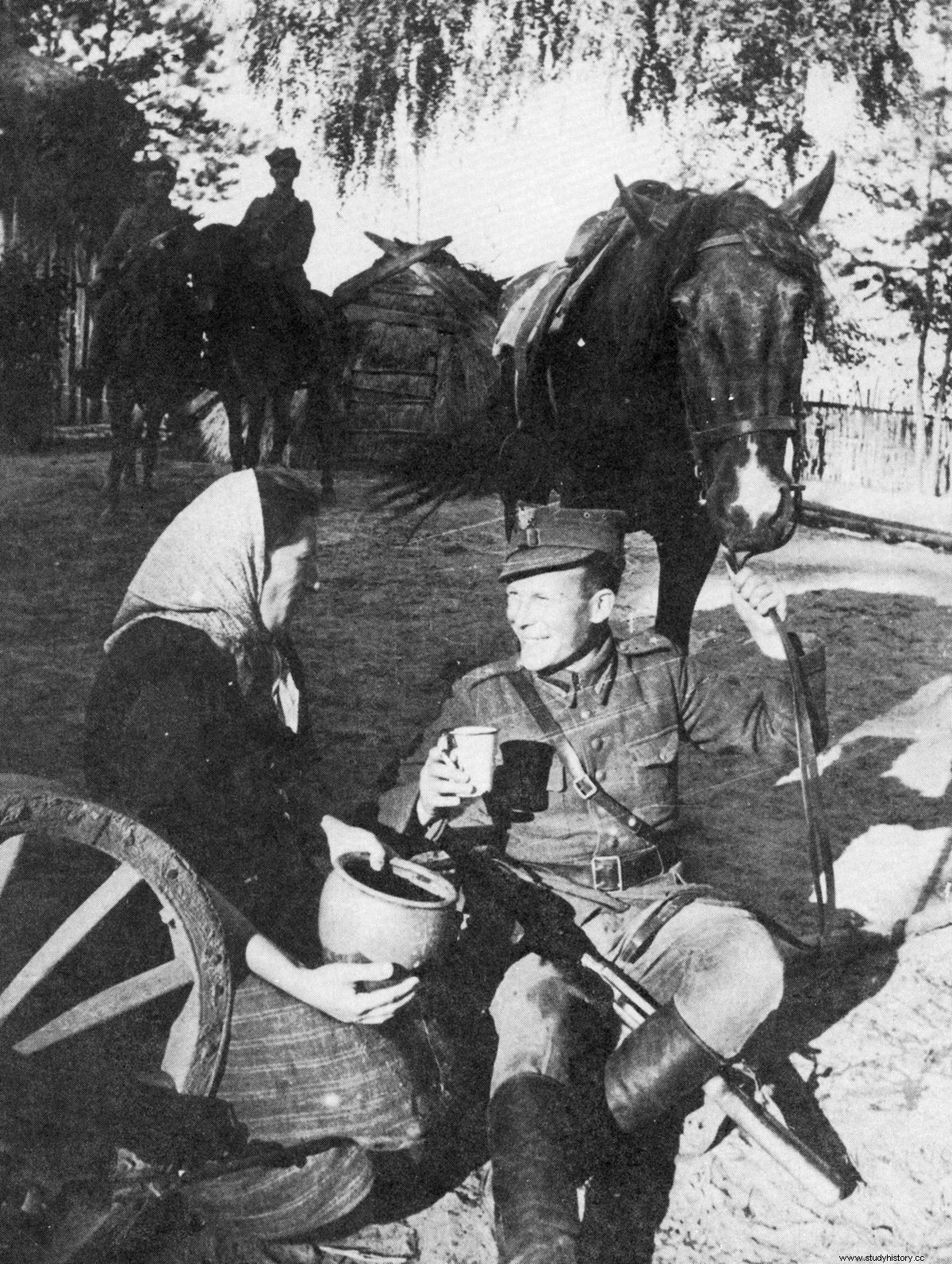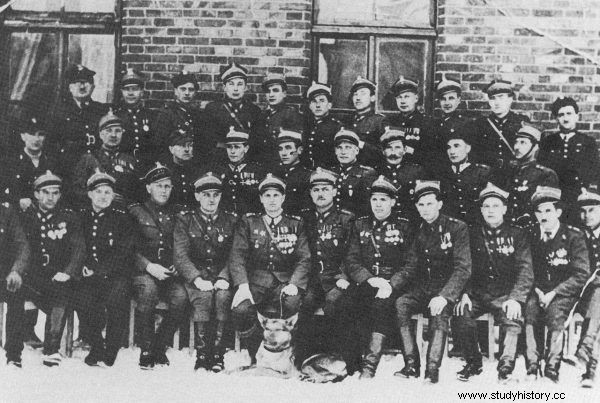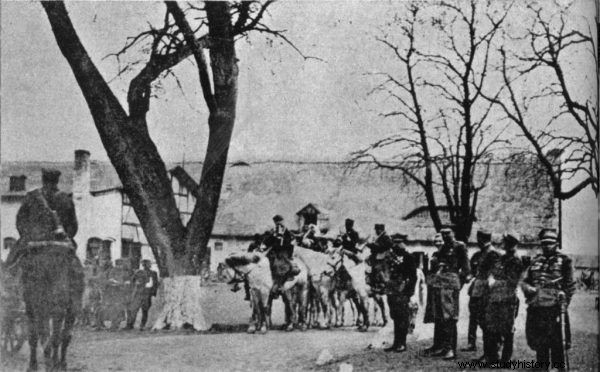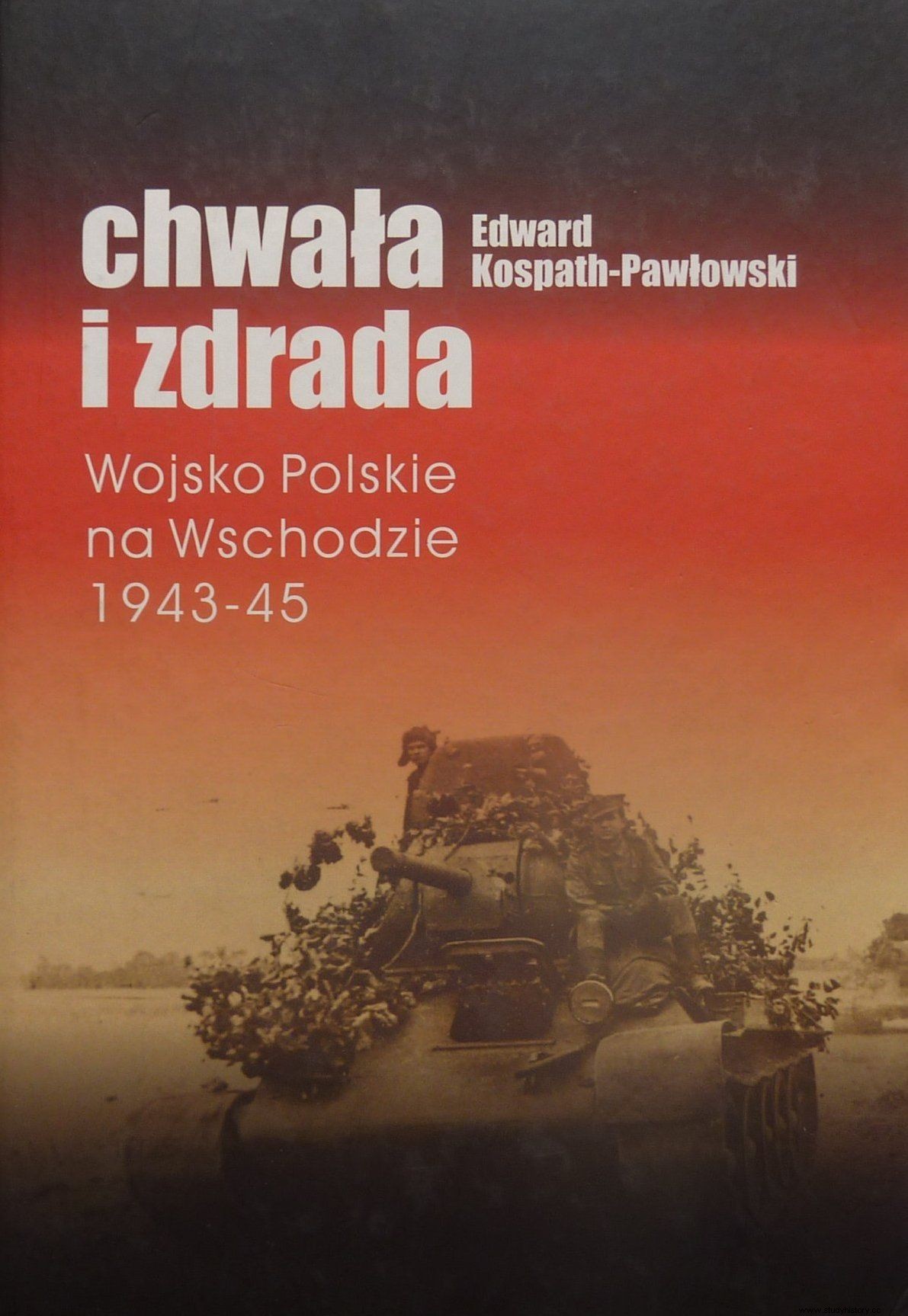Polish tanks and infantry attack the strongly fortified German positions in the village of Borujsko. The enemy, however, fiercely defends his positions. After further unsuccessful attacks, the 1st Warsaw Cavalry Brigade is thrown into the fight. On March 1, 1945, the uhlans carry out the last charge in the history of the Polish Army.
The Polish 1st Independent Cavalry Brigade was formed at the end of March 1944 in Trościaniec, Ukraine. The first brigade commander was Lt. Col. Władimir Radziwanowicz, a Russian of Polish origin, who was replaced in mid-February of the following year by Lt. Col. Konstanty Gryżewski. On February 19, 1945, the brigade received the distinctive name of "Warsaw" for its participation in the battles for the capital of Poland.
The Last Polish Uhlans
The personnel of the unit consisted of about 3,500 soldiers and in seventy-five percent consisted of soldiers from the pre-war regiments of Polish cavalry. Organizationally, the unit was divided into the 2nd and 3rd Cavalry Regiments and support units. The cavalrymen were given uniforms according to the pre-war pattern, the personal armament was a Soviet saber, the so-called the shashka and the Mosin carabiner. The heavy brigade was armed with 20 anti-tank 76.2 mm guns, 6 AA guns. 37 mm, 24 mortars 82 mm, anti-tank guns and machine guns.

The vast majority of the soldiers of the 1st Warsaw Independent Cavalry Brigade were cavalrymen who started their service even before 1939.
Poles, on the other hand, did not like the mounts very much. Initially, the brigade received small steppe horses called "Mongols". Especially the pre-war cavalrymen thought they looked downright grotesque: When I sat on one, the legs were ten centimeters from the ground and I looked like the Lord Jesus when he rode a donkey from Nazareth to Jerusalem . Fortunately, after entering Poland, the regiments began to gradually replace them with larger steeds, most often those of the Trakehner race.
Pommernstellung
The village of Borujsko (German:Schönfeld, from 1947 Żeńsko) was part of the so-called half-timbered position of the Pomeranian Wall. A small town with a church tower and a distillery chimney towering over it was one of the strongest nodes of the German defense of this position. It was defended by earth and wooden field shelters and strong points of resistance located on individual farms. The Germans had numerous Panzerfausts here - handheld anti-tank grenade launchers, deadly to tanks at short distances. The terrain itself was also favorable to the defense. Approaches to the village were dotted with deep ravines, perfect for all kinds of traps. The village was manned by experienced soldiers from two regiments of the German 163rd Infantry Division.
The Polish cavalry brigade appeared near Borujsk at the end of February 1945. Until then, this position was unsuccessfully stormed by Polish troops from the 1st and 2nd Infantry Divisions.
Another, carefully prepared attack was scheduled for March 1, 1945. From 8.30 in the morning, over two hundred Polish guns and mortars began "processing" the German positions in the village, then the assault aviation began to operate. Then, after thirty minutes, the infantry of the 5th Regiment of the 2nd Infantry Division went to attack, later supported by four T-34-85 tanks from the 1st Armored Brigade and several SU-85 armored guns from the 13th Armored Artillery Regiment. Unfortunately, a strong, massive machine fire pressed the Poles to the ground, there were many killed and wounded. Panzerfaust service personnel were not idle either, destroying two advancing T-34-85s. The Poles also failed to capture the nearby town of Żabin (Groß Sabin), which was attacked in parallel.
Critical attack
Despite this defeat, the Poles planned to strike again at 15.00. This time, next to the battered 5th Regiment, the rested 4th Infantry Regiment was to start fighting. Their activities were supported by 14 T-34-85 armored fusiliers (motorized infantry) and 5 SU-85 guns. Polish cavalry was also to join the action. From the composition of the 1st Warsaw Cavalry Brigade, a combat horse group of 180 lancers, a battery of 76.2 mm guns and platoons of heavy machine guns and mortars were separated.
Major Walerian Bogdanowicz was the commander of the group, and second lieutenants Zbigniew Starak and Mieczysław Spisacki became the commanders of two squadrons. It was a truly excellent company, because the lancers were selected from the best soldiers of the brigade. In particular, 2nd Lt. Zbigniew Starak, a brave and energetic graduate of the Cavalry School in Grudziądz and a veteran of the 1939 Polish Campaign.

Officers of the 1st Warsaw Independent Cavalry Brigade and a dog. January 1945.
According to the plan, the lancers should support the actions of the tanks and infantry at the right moment by charging through the flat, open area in the outskirts of the village. The mission seemed suicidal and the assigned task was irrational. Even in September 1939, Polish cavalrymen rarely fought in this way, usually acting as ordinary infantry. Meanwhile, the last Polish uhlans were to attack enemy positions full of machine guns in the open field, at full gallop, with a saber in hand! The commander of the charge was to be 2nd Lt. Starak.
This further infantry and tank attack was again stopped by the enemy. The foot soldiers lay in the cross fire of the German machine guns, and the battlefield was covered with the greasy, black smoke of burning Polish tanks. The Panzerfausts have taken their death toll again.
Charge
In this difficult situation the uhlans took action. At. 15.45 at the signal of the red rocket, 2nd Lt. Starak gave a historic, pre-war order: Lance! Sabers in hand! 160-170 cavalry fell on the enemy. The smoke over the battlefield additionally masked their movements, enabling a close approach to the German positions. Captain Stanisław Arkuszewski, the political officer of the brigade, this is how he remembered the charge he observed:
It was a breathtaking spectacle. The horses raced in a crazy run, in a few minutes overcoming over two kilometers, full of various obstacles, space. The shouts of "hurray" were heard amid the roar of engines, missile explosions and the incessant rattle of machine guns. (…)

Brigade soldiers during the fights for Wał Pomorski. March 1945.
Squadrons broke through obstacles, chopping and trampling the Germans blocking their way. Surprised and confused by this extraordinary and lightning attack, they did not manage to organize resistance at first. (...) The advanced outposts did not endure nervously. Leaving their positions, they tried to protect themselves between the buildings.
Rushing at the head of the lancers, 2nd Lt. Zbigniew Starak, in turn, recalled: The platoons were now racing almost in one line in a gallop. I was tearing my throat straightening up. It was a marvelous sight, this raging wave of our onslaught. We passed on foot, passed tanks. What do you think about at a time like this? Just one thing:get to the enemy. We jumped over the recesses of the panzerfausters, the horses took the ditches, whoever leaned out or ran got a saber!
Victory
The Uhlans jumped over the German positions, but the fight was not over yet. After hiding the horses in a nearby grove, the cavalrymen on foot attacked individual points of German resistance in the village. They were effectively supported by the Polish T-34-85, which, taking advantage of the chaos during the cavalry attack, approached the buildings of Borujsk. After about an hour, the enemy was driven out of the countryside. The lancers of the 1st Warsaw Cavalry Brigade were relieved in Borujsk by their colleagues from the 2nd Infantry Division in the morning of the next day.

The article was based, inter alia, on the book by Edward Kospath-Pawłowski with the subtitle "Glory and betrayal. Polish Army in the East 1943-1945 ”(Inicjał 2010).
During the fight 7 cavalrymen were killed and 10 others were injured. On that day, much higher losses were suffered by other units of the Polish Army:140 killed and about 300 wounded and injured. The opponent lost up to half a thousand people killed, moreover, the Poles took 50 prisoners. The most important thing, however, was that a breach was made in the German positions, which opened the way for the 1st Polish Army to Pomerania.
The 1st Warsaw Cavalry Brigade ended its combat route north of Berlin, on the Elbe. Shortly after the end of the war, a larger tactical union was formed on its basis:the 1st Warsaw Cavalry Division, but in January 1947 this unit was disbanded.
In a rather unusual way, the hero from Borujsk, Sec. Zbigniew Starak. This brave cavalryman was immortalized on the Monument of the Millennium of Polish Riding in Warsaw. A bronze lancer, charging with a drawn saber next to a mustached Piast warrior, is the commander of the last charge of the Polish cavalry. In the mid-1980s, the then Colonel Starak posed for the creators of this monument. On one of the brass plaques, among 43 names commemorating the most important battles in the history of Polish cavalry, there is also the inscription:BORUJSKO 1945.
